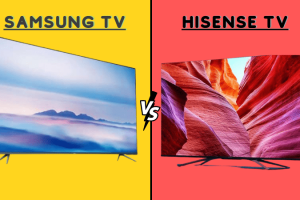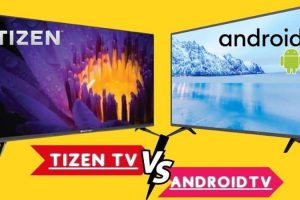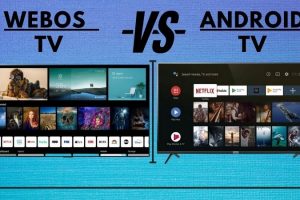If your room is really bright due to ambient light, your TV display might get visibly dim and you might also see glare. While one option is to change the location of your TV, you can also avoid this issue by using the best type of TV for bright rooms.
So, What is the best type of TV for Bright Rooms? QLED and OLED are the two most popular options these days. You might want to know “Is QLED good for bright rooms or if OLED is better. ” Let’s answer this question once and for all.
What is the Best Type of TV for Bright Rooms? QLED vS OLED
QLED TVs are the best type of TV for bright rooms because they have the highest peak brightness up to 2000 nits and more while OLED TVs can reach 500-600 nits. So QLED is the best type of TV for Bright Rooms.
Now let’s dive deep to understand the differences between QLED and OLED, so you know very well what you have to compromise to get the peak Brightness.
Check our guide on 10 Best TVs for Bright Rooms.
QLED
It stands for Quantum Light-Emitting Diode. QLED is just like the LED TVs we regularly use, and the only difference is that it has nanoparticles called quantum dots that give better brightness and color effects. Sony first introduced this technology. Later, Samsung also started to sell its QLED TVs.
Direct sunlight should provide 1,500 nits for indoor displays, whereas QLED displays can produce 2,000-4,000 nits. But if you’ve heard about OLED TVs’ unrivalled clarity and precise black levels, they may not be the ideal choice for your room’s ambient illumination.
OLED
Organic Light-Emitting Diode is the abbreviation for it. In OLED TVs, there is no need for a backlight. As a result, each OLED pixel generates its illumination.
An OLED TV turns off the pixels, unlike a QLED or LED TV, which decreases its backlight and blocks what is left for gloomy scenarios.
What Is Good QLED or OLED For Bright Room?
Brightness: QLED and OLED
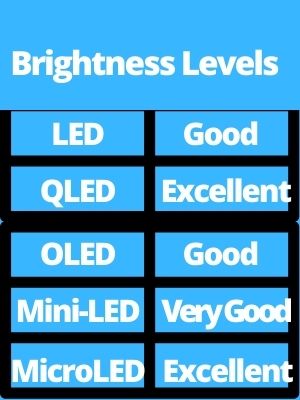
QLEDs can raise their brightness dramatically, providing them with an advantage over OLEDs in bright settings. This is primarily due to the QLED panels’ usage of advanced technologies. Quantum dots, minuscule particles that emit a specific color light when struck by light, were popularized by Samsung.
Samsung has developed a newly refined aluminium compound that can improve the efficiency of quantum dots and the natural ability to produce more realistic colors in QLED TVs. Many earlier TVs had red, green, and blue color filters, but this technology replaced them. So, QLEDs are the best TV for bright rooms.
So this answers our question which is the best type of tv for bright rooms. While OLED is the best type of TV for dark rooms.
Panels: QLED and OLED
When it comes to eliminating glares and reflections, the powerful backlighting of QLED panels sets them apart from other displays. The dazzling whites of Samsung’s QLED TVs may be achieved with a brightness of between 1,000 and 2,000 nits. Usually, HDR images require a minimum of 1000 nits of illumination.
The self-emissive pixels of OLED screens don’t require light. Thus they can’t achieve the same level of brightness. Pixels in these TVs, which can number in the millions, light up in various hues when the power is applied. The advantage of OLED pixels is that they can be completely black, giving in deeper, genuine blacks
Color Space: OLED and QLED

OLED was previously an undisputed leader in this field. But the use of quantum dots in QLED TVs, on the other hand, is claimed by Samsung to improve color accuracy, brightness, and volume. Quantum dot TVs are known for their vibrant colors, but yet OLED has a significant advantage in normal viewing conditions as seen in the image.
Additionally, OLED TVs employ white light to produce an even more comprehensive range of colors, resulting in more vivid and accurate images.
Consumption of Power: OLED and QLED
Remember that OLED TVs may be made thinner and are more environmentally friendly than LCD TVs that rely on backlighting because they require less electricity. Also, OLED TVs emit less heat as compared to QLED TVs.
In an area with a lot of ambient lighting, OLED panels do not seem as crisp as QLED panels, even though OLED panels provide superior overall image quality and broad viewing angles. While Samsung may have triumphed in this minor war, it is far from finished innovating.
Viewing Angle: OLED and QLED
The angle for viewing the screen on QLED panels is not what we expect. When we change our position and move up or down or side to side, the quality of the picture starts to blow away in terms of color, brightness, and contrast. Despite TV manufacturers’ efforts to address the problem, the intensity varies from model to model.
On the other hand, OLED TVs can be viewed at extreme viewing angles up to 84 degrees, with no luminance loss. Although anti-reflective coatings have helped some QLED TVs improve their viewing angles, OLED still has a distinct advantage. When it comes to family movie nights, an OLED TV is the best option because it ensures that no one gets a bad seat.
Response time, input lag, and refresh rate: QLED and OLED
When comparing QLED and OLED screens, it’s important to think about response time, input lag, and refresh rate. The response times of QLED displays, which use Quantum Dot technology, are usually faster than those of OLED screens.
This makes the motion blur less, which makes it better for fast-paced games or material with lots of action. On the other hand, OLED’s organic LED technology has better contrast and deeper blacks because each pixel is controlled separately.
This makes the images more vivid and realistic. When it comes to input lag, both technologies have come a long way, but QLED tends to be a little bit better.
When it comes to refresh rate, both QLED and OLED can handle high refresh rates, but QLED panels with higher refresh rates have been more common. In the end, it’s up to the user to decide between QLED and OLED. QLED is better at response time and input lag, while OLED is better at brightness and color reproduction.
Screen Size: QLED and OLED
OLEDs have gone a long way since their inception. OLED panels had a maximum size of 55 inches when the technology was still in its infancy. Screen sizes of up to 97 inches are now possible at a high price. Regarding size, QLED technology is easier and less expensive to manufacture.
Lifespan: QLED and OLED
According to the LG company, if you watch their OLED TVs for 54 years, five hours per day, the brightness level of their OLED TVs would lower down to 50%. It is unclear whether this is correct, as OLED TVs have only been on the market since 2013.
Even though QLED is a more recent development, the LED that powers it has been around for quite some time.
QLED vs. OLED: Which technology is better?
In today’s TVs and monitors, cutting-edge display technologies like QLED (Quantum Dot Light Emitting Diode) and OLED (Organic Light Emitting Diode) are used. Each technology has its strengths and weaknesses.
Quantum dots are used in the backlight of QLED TVs to improve color and brightness. This gives QLED TVs bright colors and high peak brightness, making them great for bright rooms and places.
Also, QLED displays tend to last longer and are less likely to have their screens burn in than OLED displays.
OLED TVs, on the other hand, don’t need a separate backlight because each pixel gives off its own light. This makes it possible for OLED displays to have true blacks and great contrast, which makes them great for dark rooms and makes the watching experience more immersive.
OLED screens also have faster reaction times, which makes them good for things like gaming that move quickly.
Ultimately, the decision between QLED and OLED comes down to your viewing environment, content preferences, and budget. If bright rooms and bright colors are important to you, QLED might be a better pick.
On the other hand, OLED would be a good choice if you like deep blacks and contrast, especially for watching movies.
Conclusion
In final words, QLED is the best type of TV for bright rooms due to higher brightness, a longer lifespan, wider screen sizes, and fewer chances of burn-in. While other screens deliver a greater viewing angle and deeper black depths. OLED provides a better viewing angle and uses less power, making it ideal for gaming and even healthier. However, selecting between them is a personal choice. OLED technology shines when it comes to lighting control.
Jason Reynolds
I have been working in the electrical and Audio/Visual field for over 19 years. My focus for EagleTVMounting is to provide concise expertise in everything I write. The greatest joy in life is to provide people with insight information that can potentially change their viewpoints. Our #1 goal is just that!


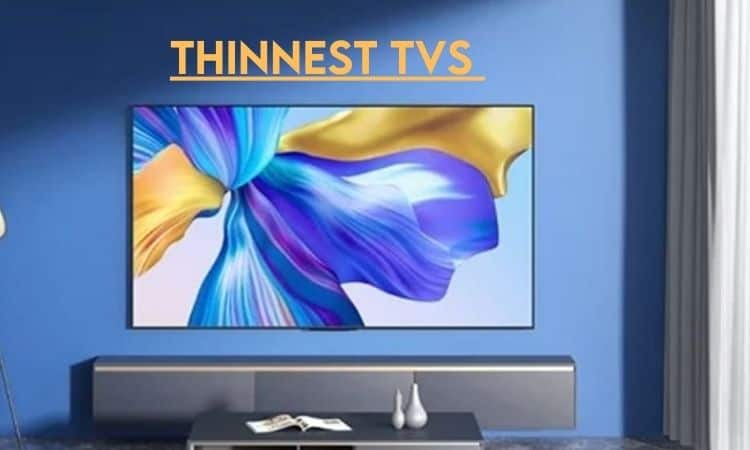



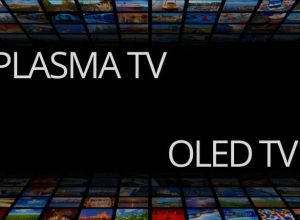
![Best Smart TVs Under $200 10 Best TVs Under $200 in 2022 [Smart, 4K, Top Rated]](https://eagletvmounting.com/wp-content/uploads/elementor/thumbs/Best-Smart-TVs-Under-200-1-pxsvk5gy9n9zpv0lrzhk644n1gvwdxv32ixo8gyqoo.jpg)
